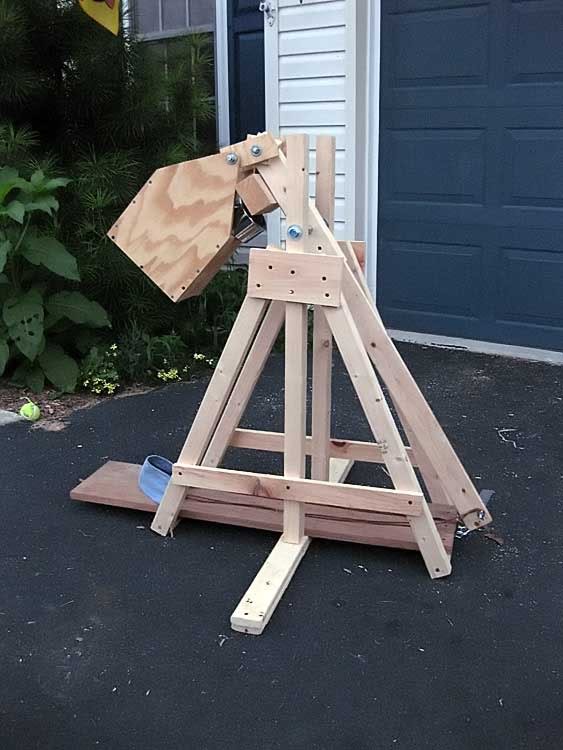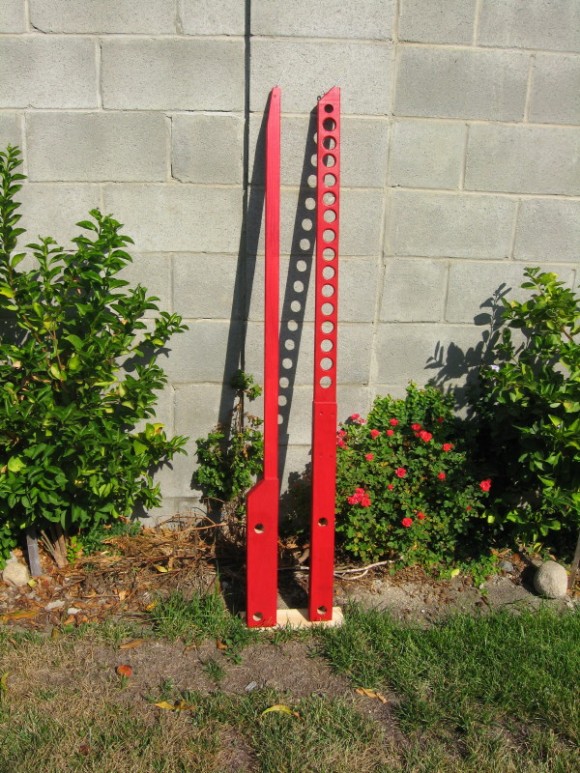Tuning A Trebuchet For Maximum Distance – A Look at the Components and Variables

Here are some notes on adjusting your trebuchet or catapult to help maximize the distance it will launch an object. Happy flingin’!
========================
Catapults and trebuchets originated more than 2000 years ago, and over time became highly sophisticated machines that represented the pinnacle of medieval engineering. The largest machines were capable of consistently launching half-ton boulders hundreds of feet, knocking down thickly fortified stone castle walls – no small feat!
The general working property of a trebuchet isn’t too complex – it’s a large lever that works by multiplying the speed on a short arm by the ratio of its length compared to the long (throwing) arm. Gravity is used to provide the energy for this, in the form of a counterweight, and a sling is attached to the end of the throwing arm to further multiply the speed of the projectile. But within those few components, you have a multitude of variables, all which interact to affect the distance a machine can hit.
Here are some good tips for tuning your trebuchet for maximum effect:
Physical Dimensions:
One of the first pieces to consider is the ratio of the short arm to the throwing arm. General wisdom has a 5:1 ratio being the norm for a standard trebuchet, although 4:1 is sometimes used. The longer the ratio, the greater the speed that tip of the throwing arm will reach – but also increasing the force required to move it quickly.
A second component is the height that the axle will be placed above the platform of the trebuchet. Larger distances allow the throwing arm to be placed higher up, which increases the distance that it will travel when released. The further it travels, the more it will accelerate, which again increases tip speed on the throwing arm.
Weight:
Obviously, there’s a connection between the counterweight and the throwing arm/projectile. General advice is that the optimal ratio is 133:1. A golf ball projectile (1.62 oz) should fire best with 13.46 lbs of counterweight – and a 14 lb bowling ball should have 1862 lbs pulling on the other side of the arm to reach maximum distance. Of course, this is all dependent on other variables and may differ for you, but is a good starting point for your machine.
The weight of the throwing arm should also be kept as low as possible, but not without damaging the integrity of it. A lightweight but strong material is advised for best results – for smaller machines ash can used, but on larger trebuchets, the strength of oak, aluminum, or even carbon fiber becomes necessary.
It is advisable to taper the throwing arm to keep it light at the tip. Meanwhile, the short arm should be stout and strong, as it has a lot of mass to support. Don’t be afraid to break it while testing – it’s good to know the limits and get as close to them as possible.

Sling:
Sling length and pin angle work together to affect the angle of release. Longer length slings have a lower angle of release, good for line drives (if you need a direct hit against the castle gate, for instance). Shorter lengths will result in a higher angle of release, best for lobbing projectiles over tall objects. The general ratio to start at is a sling length (arm connection to tip of pouch) 80% the length of the throwing arm.
Modifying the release pin angle will also affect the trajectory of the launch. Forward facing by 30º is the norm – but the length of the sling and the angle of the pin interact greatly, so make sure to change both while testing to exploring the full potential.
Wheels:
Trebuchets large and small tend to have wheels, which initially appear to be for transport. And while this would be true for minor adjustments, the largest trebuchets were so massive and heavy that they would have to be assembled on location. The real purpose of the wheels is to allow the entire mechanism to move back and forth as the counterweight is released, keeping the weight’s movement as vertically linear as possible. A weight that rotates downwards loses some of the power of gravity as the force on it has to be transferred into a forward and then backward motion. But if the counterweight drops directly downwards, it can maximize the effect of gravity.
Wind Resistance:
Not a major factor until very large builds are happening, do to the squaring effect of resistance due to wind. But for those who are working with large machines, making the moving parts (throwing arm, sling, pouch) as invisible as possible to the wind will help increase the distances.
Also, film and review your throws. A lot can be seen by checking the frames of your launches to determine what is happening, and where.
Many of these notes were taken from The Hurl, a great community of trebuchet and catapult enthusiasts. This thread on their forum details the tuning of a smaller trebuchet that was able to go from 30′ to 115′ throws with a variety of modifications. Quite an increase.
Ripcord’s trebuchet website has a tremendous amount of information on building and improving your catapult through better sling design and more. A must read.
===============
Tonight (Dec 12) I will be hosting a live discussion on the Craftsman Experience live feed with Joseph Budka, who just completed a bowling ball launching trebuchet for this show. We spent a couple days playing with the machine and will discuss the trials and tribulations of assembling one of these awesome projects (including recovering from a catastrophic malfunction). Make sure to tune into the Craftsman facebook page and click the “Experience” tab to watch. 730pm EST, 430pm PST.
